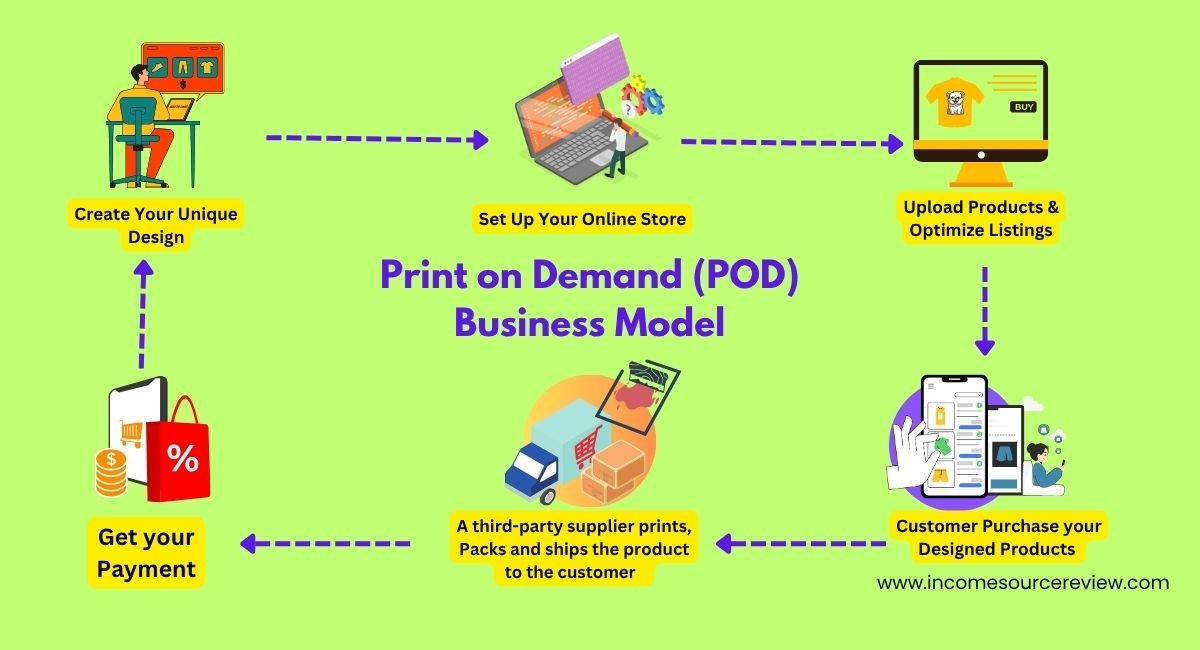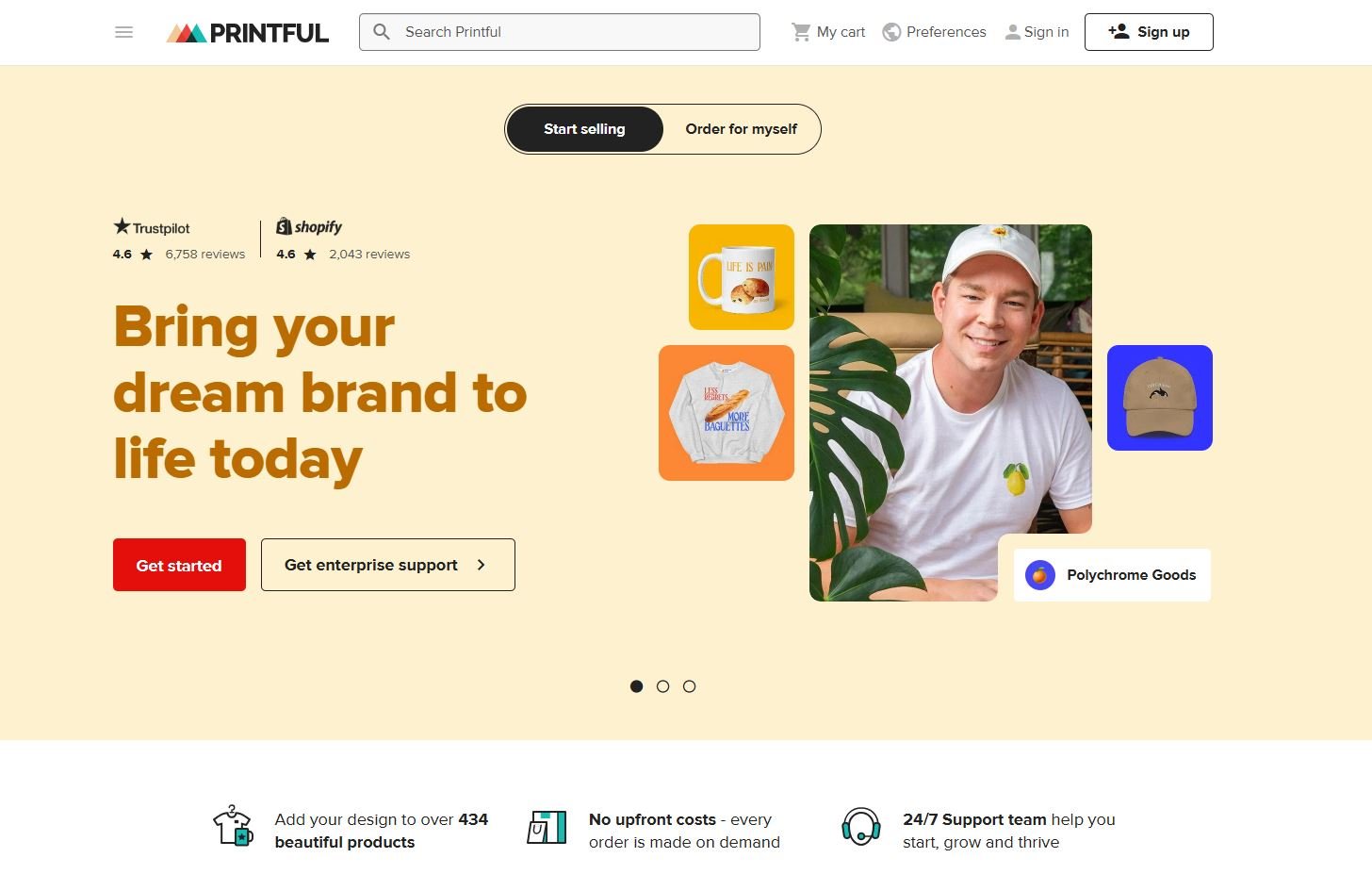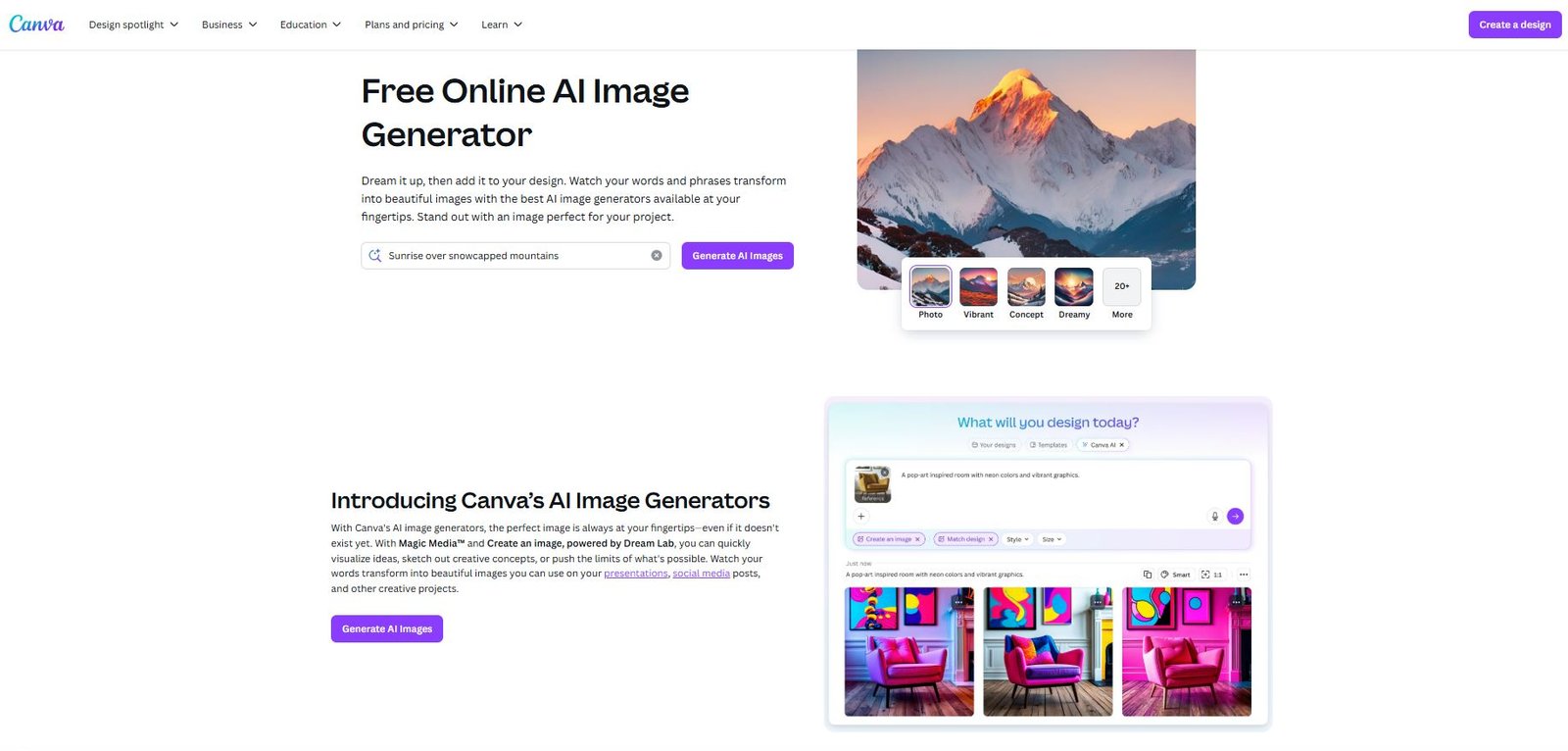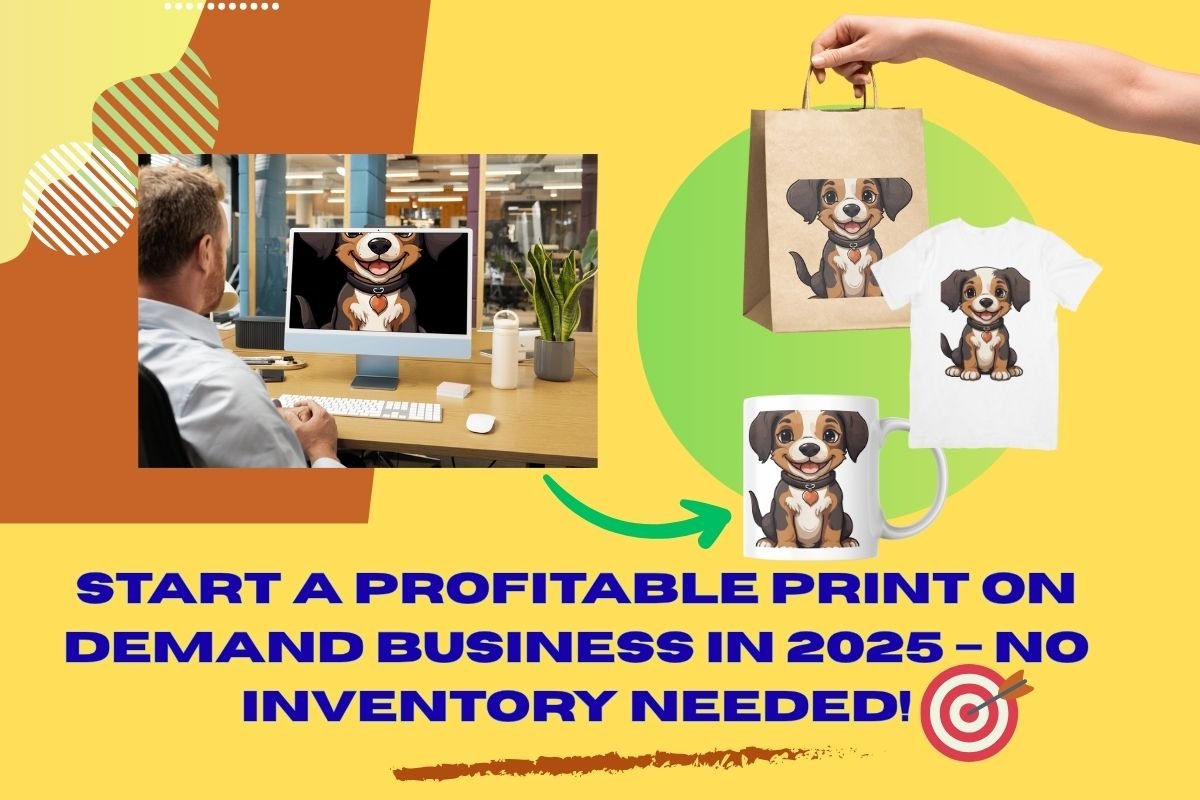Looking to build a passive income stream in 2025 without inventory, upfront investment, or complex logistics? Learn how to start a print on demand business from scratch and turn your creativity into cash.
Introduction: Why Print on Demand Business Will Rise in 2025
Over the past few years, the e-commerce world has undergone significant changes. With the application of artificial intelligence (AI), automation tools, and global fulfillment networks improving, print on demand (POD) has emerged as one of the most accessible passive income sources online.
Without any inventory or hiring a technical team, you can now launch your online brand for selling custom-designed products with print on demand (POD) models. Whether you’re an artist, content creator, or complete beginner, you can start your business easily by following the guide.
In this guide, you’ll discuss how to start a print on demand (POD) business model step by step, which will help you get a complete understanding of another passive income source.
Let’s build your business!
Table of Contents
What is Print on Demand (POD)?
Print on demand (POD) is a fulfillment method where custom products (like T-shirts, mugs, phone cases, and journals) are only printed with the user-chosen design and shipped when a customer places an order.
It’s like a Dropshipping model — but this passive income model is different with your unique designs and branding.
- There is no need for upfront inventory when starting a POD business.
- No warehouse or equipment required to store.
- Implement marketing strategies.
- Sell globally with local fulfilment.
- Earn passive income regularly, even when you are sleeping.

Reasons for Starting a Print on Demand Business in 2025?
Here’s why POD is one of the top online business models in 2025:
- Low Startup Cost: A low initial investment is required to start a print on demand business. With a POD business model, you won’t need inventory or any special equipment. You can launch a business with as little as $0 on Etsy or Redbubble.
- Scalable & Passive: Make a unique design for your customers by using your creativity. Once your designs are listed on the site, they will sell multiple times and generate passive income for years to come. As sales increase, you can easily scale your business.
- Location Independent: You can start your business from anywhere in the world with internet access or Wi-Fi. You can easily reach a global audience for your POD business.
- AI and Design Tools Are Easier than Ever: It is easier than ever to use various AI and design tools like Canva AI, Kittl, and MidJourney to create your stunning designs in minutes.
- Demand is Rising: As a report on Straitsresearch.com, the global Print on Demand (POD) market is expected to reach from $12.39 billion to $57.49 billion+ by 2033. (source: https://straitsresearch.com). Scale up your business by optimizing effective marketing strategies to meet the growing demand.
How to Start a Print on Demand (POD) Business Step-by-Step in 2025
If you are interested in creating something different with your creativity, here is the step-by-step guide to start a successful print on demand (POD) business in 2025.
Step 1: Select a Profitable Niche for your POD Business
Selecting a profitable niche for your print of demand business is the first step to getting started. Build your entire POD business strategy and target audience based on your selected niche. Don’t try to sell your design or custom products to everyone. Think about the following factors at the time of choosing your POD business niche:
- Interest and Passion – encourage to create a unique design
- Clear Identity and market demand – to get an idea about a profitable POD niche
- Low Competition niche – for more passive income
- Trends and evergreen niches – increase marketing opportunities.
- Understand audience’s needs and buying behaviour – drive more traffic.
- Higher conversion niches –
List of Top Print on Demand (POD) Niches in 2025:
- Pet lovers
- Fitness motivation
- Spiritual & manifestation themes
- Tech & AI humor
- Local pride/hometown merch
- Retro 90s nostalgia
- Fashion for Youth
- Festive Season
Pro Tip:
Use Google Trends plus the Etsy search bar to spot growing niche opportunities to maximize conversion.
Step 2: Pick the Right Print on Demand (POD) Platform

Choosing the right Print on demand (POD) platform for your business is very important. POD platforms help to run your business successfully by offering various resources and POD services. Consider the key points while choosing a POD platform:
- Offer a global print on demand (POD) service to reach a wider audience.
- Must integrate with an e-commerce platform for selling POD products.
- Offer a wide range of product catalogs to fulfill customer needs.
- User-friendly platform dashboard to easily set up a business.
- Provide a transparent price option.
- Lower profit margins –offering less commission for using the marketplace for POD business.
- Provide resources such as various design tools and high-quality printing options.
- Fast fulfilment time (labelling, packaging, and delivering of POD products to the customer).
- Reliable customer support and payment gateway.
Consider the top print on demand platforms to start your POD business:
| Platform | Best For | Integration Options |
|---|---|---|
| Printify | Product variety, global shipping | Etsy, Shopify, Wix |
| Gelato | Fast EU (Europe) & US delivery | Shopify, WooCommerce |
| Printful | Wide product range, Branding & packaging | Etsy, Amazon, Shopify |
| Redbubble | Built-in traffic | No website needed |
| TeePublic | Simple selling | No integration needed |
Pro Tip:
Start your POD business on Etsy or Amazon, and use Printify for the best mix of traffic and control.
Step 3: Create Your Unique Designs
Create your unique designs, patterns, and slogans that are consistent with your chosen niche. Nowadays, it doesn’t matter if you have any design experience or not; you can choose from various design tools available on the market and easily create your design. You can also use vector images, clip art, and other elements that are available as free resources.
Consider the few factors before designing:
- Thorough research for market trends
- Understand customer demand
- Analyze your competitors
- Look for unique design ideas
- Utilize graphic design tools
Tools to Design POD Products in 2025:
| Design Tool | What It Does |
|---|---|
| Canva AI | Beginner-friendly design templates |
| Kittl | Advanced typography & vintage style |
| MidJourney | AI image generator for graphics |
| Placeit | Creates product mockups and ads |
| Creative Fabrica | Pre-made fonts & graphics for commercial use |
Design tips to optimize for printing:
- Keep it simple, readable, and niche-focused.
- Use 1–2 fonts per design.
- Test different color backgrounds.
- Consider image resolution (300 DPI for optical print).
- Choose the File format and color mode as per your POD platform.
- Ensure the design looks good on various products using vector graphics.

Step 4: Set Up Your Online Store
After creating a unique design, you will set up your online store for a POD business. To set up a POD online store, you will need to list your design, create mockups on custom products, set a price tag, and implement a marketing strategy to sell. You can sell POD in three main ways:
1. Partnership with a Marketplace (Etsy, Amazon, Redbubble)
Don’t have your own online store? To sell your POD products, join a reputable online marketplace like Etsy, Amazon, or Redbubble. These online marketplaces offer various POD services like listing products, shipping, payment gateway, and customer service to scale up your business. Here are a few features of an online marketplace:
- Provide an easy process to set up an online store quickly
- Built-in traffic
- Required marketplace fees
- Free tools and resources
- Provide features like customer service, shipping options, and a payment gateway
- Integration with an e-commerce platform
- Less control over branding
Consider marketplaces: Etsy, Amazon, Redbubble, or Zazzle.
2. Create Your Website (Shopify, WooCommerce)
Create your own website using various e-commerce platforms like Shopify, WooCommerce, and Wix to sell your custom-designed products. Your business website helps to create your brand and increase authority for long-term business goals. Below are some highlights of a business website.
- More control and customization.
- Long-term asset building.
- Create branding identity.
- Set up a payment gateway and shipping option.
- Requires your own traffic.
Consider e-commerce platforms: Shopify, WooCommerce, and Wix
3. Social Selling (TikTok, Instagram)
Use the wide traffic source of different popular social media platforms like TikTok, Instagram, Facebook, and YouTube to grow your POD business. You can create and post engaging content on the social platform or make ads to generate more conversions. Consider the following factor:
- For a wider traffic source, utilize social media platforms
- Connect with global audiences
- Viral potential of your content, meaning the opportunity for more sales.
- Great for trends and influencers
Pro Tip:
For beginners, Etsy plus Printify or Shopify plus Gelato is the perfect combo.
Step 5: Add Products & Optimize Listings
It’s not enough to just create your online store; you should also effectively add products and optimize listings for a print on demand (POD) store for sale. Your product listings should include:
- SEO-optimized title (with your niche plus product type) – helps product listings rank easily in the search results and drive more traffic to your site.
- High-quality mockups – to show what your design will look like on the custom product in different sizes and formats. A high-quality mockup of your product helps attract more audience, which means more conversion opportunities.
- Engaging product descriptions with benefits – which can also help increase revenue when used to connect potential customers with your content.
- Targeted tags and keywords – help to optimize product listing to appear top of the search results that attract POD customers.
Example of SEO title: “Funny Gym Quote T-Shirt for Fitness Motivation – Workout Apparel for Women”
Pro Tip:
Use tools like Everbee or Alura for Etsy SEO keyword suggestions.
Tips to optimize Listing:
- Research keyword, and incorporate into title, description, and tags
- Use a quality product image
- Provide promotional offers and discounts
- Use a mobile-responsive product page
- Encourage positive customer reviews
- Utilize different traffic sources
- Connect e-commerce platform
Step 6: Launch Your Online Print on Demand (POD) Store
Now it’s time to launch your Print on Demand (POD) Store online successfully. But it’s very important to check a few factors before launching a POD store online.
- Set up policies like returns and shipping orders
- Set up an easy payment gateway and refund policy
- Analyze one product order to ensure quality
- Add branding elements – create logo, banner, profile image
- Engage with your audience – by responding to customer inquiries, FAQs, building a community, and using social media platforms
- Create a user-friendly interface and a visually engaging store.
- Tracking order and shipment status.
- maintaining order fulfillment time
Step 7: Promote and Grow Your POD Store
After launching your POD store, it is most important to implement various marketing strategies to drive traffic to your business platform. Here are a few marketing strategies to promote your POD items and grow your business:
Free traffic channels:
- Create SEO-optimized Etsy listings of your POD products
- Use Pinterest pins of your POD products
- Create Facebook groups that align with your chosen niche.
- Reddit & Quora engagement
Content Marketing Strategy:
Promote your POD products by creating valuable, engaging content like high-quality images, blog posts, reviews, infographics, or videos related to your selected niche. Share helpful content that meets your customers’ needs through your site, email list, social media, and other POD platforms.
Utilize relevant keywords and implement proper SEO to boost your content’s visibility in search results for your target audience.
Social Media Marketing:
Use social media platforms to post high-quality images, videos, and reels of your POD products and reach a wider audience.
Build a community around your products, reply to comments and messages to increase your authority and social engagement.
Use social media platforms like Facebook, Instagram, TikTok, YouTube, and Pinterest.
Paid promotion:
- Utilize Etsy ads ($2–$5/day to test)
- Collaborate with an Instagram/TikTok influencer to create sponsor posts, reviews to promote products.
- Run Facebook Ads for retargeting warm audiences
- Use Google Ads, YouTube Ads to reach wider audiences
Must-Have Tools for Print on Demand (POD) in 2025
Here’s your toolkit to run a successful print on demand business:
| Tool | Purpose |
|---|---|
| Printify | Print fulfillment plus global shipping |
| Canva | Design creation |
| Kittl | Design creation |
| Everbee | Etsy keyword research & competitor analysis |
| Placeit | Product mockups & ad creatives |
| ChatGPT | Product descriptions, captions, emails |
| Pinterest Trend | Discover viral content ideas |
| ConvertKit | Build email list & send campaigns |
Bonus: Tips to Succeed in Print on Demand (POD) for Long-Term
- Focus on 1 niche before expanding
- Build an email list for repeat buyers
- Keep up with seasonal trends (Q4, holidays)
- Test at least 5–10 designs per product
- Be consistent. It may take 30–60 days to get sales traction
Conclusion: Ready to Launch Your Print on Demand Business?
In 2025, starting a print on demand business is not just possible — it’s one of the smartest ways to create passive income online.
With the rise of automation, global shipping partners, and creative tools, there’s never been a better time to tap into your creative potential and build your own eCommerce brand — even if you’re starting from scratch.
So pick a niche, create your designs, and start your POD journey today.
Summary Checklist
- Choose a profitable niche
- Use POD platforms like Printify or Gelato
- Create designs using Canva, Kittl, or AI tools
- Set up your store (Etsy or Shopify)
- Optimize product listings
- Use free and paid traffic sources
- Track performance and scale
Frequently Asked Questions (FAQs)
Is print on demand profitable in 2025?
Yes! With the right niche, quality designs, and platforms like Etsy or Shopify, many sellers are making $1,000–$10,000/month in passive income online.
How much does it cost to start a POD business?
You can start with $0 using Redbubble or TeePublic. But for Etsy plus Printify, expect ~$20–$50 for listings and test orders.
What is the best POD platform for beginners?
Printify integration with Etsy is the easiest and most beginner-friendly combo. Etsy brings the traffic, and Printify handles the fulfillment.
Can I do print on demand without a website?
Yes, marketplaces like Etsy, Redbubble, and Amazon Merch allow you to sell POD products without a personal website.
Do I need to be a designer?
No. You can use tools like Canva, Kittl, MidJourney, or purchase pre-made designs from Creative Fabrica.
How long does it take to make your first sale?
Some sellers get sales within a week, others take 30 plus days. It depends on your niche, product, and SEO.
What are the most trending POD products in 2025?
AI-inspired T-shirts
Custom pet mugs
Spiritual journals
Fitness quote hoodies
Local city pride tote bags
How do I get traffic to my POD store?
Focus on SEO, Pinterest, and Etsy ads. Then expand to Instagram, TikTok Reels, and email marketing.
Is POD passive income or active work?
At first, it requires effort (design, listings, marketing). But once your listings rank and automate, it can become a reliable stream of passive income online.
Response

This was beautiful Admin. Thank you for your reflections.





Leave a Reply